Interocular Differences in Spatial Frequency Influence the Pulfrich Effect
Abstract
1. Introduction
2. Materials and Methods
2.1. Participants
2.2. Apparatus
2.3. Stimuli and Procedure
2.4. Data Analysis
3. Results
4. Discussion
5. Conclusions
Author Contributions
Funding
Conflicts of Interest
References
- Pulfrich, C. Die Stereoskopie im Dienste der isochromen und heterochromen Photometrie. Naturwissenschaften 1922, 10, 751–761. [Google Scholar] [CrossRef]
- Diamond, A.L. Simultaneous brightness contrast and the Pulfrich phenomenon. JOSA 1958, 48, 887–890. [Google Scholar] [CrossRef] [PubMed]
- Kitaoka, A.; HAshida, A. variant of the anomalous motion illusion based upon contrast and visual latency. Perception 2007, 36, 1019–1035. [Google Scholar] [CrossRef] [PubMed]
- Lit, A. The magnitude of the Pulfrich stereophenomenon as a function of binocular differences of intensity at various levels of illumination. Am. J. Psychol. 1949, 62, 159–181. [Google Scholar] [PubMed]
- Reynaud, A.; Hess, R.F. Interocular contrast difference drives illusory 3D percept. Sci. Rep. 2017, 7, 5587. [Google Scholar] [CrossRef]
- Wilson, J.A.; Anstis, S.M. Visual delay as a function of luminance. Am. J. Psychol. 1969, 82, 350–358. [Google Scholar] [CrossRef]
- Westheimer, G. The Fourier Theory of Vision. Perception 2001, 30, 531–541. [Google Scholar] [CrossRef]
- Campbell, F.W.; Green, D.G. Optical and retinal factors affecting visual resolution. J. Physiol. 1965, 181, 576–593. [Google Scholar] [CrossRef]
- Breitmeyer, B.G. Simple reaction time as a measure of the temporal response properties of transient and sustained channels. Vis. Res. 1975, 15, 1411–1412. [Google Scholar] [CrossRef]
- Harwerth, R.S.; Levi, D.M. Reaction time as a measure of suprathreshold grating detection. Vis. Res. 1978, 18, 1579–1586. [Google Scholar] [CrossRef]
- Nachmias, J. Effect of Exposure Duration on Visual Contrast Sensitivity with Square-Wave Gratings*†. J. Opt. Soc. Am. 1967, 57, 421–427. [Google Scholar]
- Watt, R.J. Scanning from coarse to fine spatial scales in the human visual system after the onset of a stimulus. J. Opt. Soc. Am. A 1987, 4, 2006–2021. [Google Scholar] [PubMed]
- Musselwhite, M.J.; Jeffreys, D.A. The influence of spatial frequency on the reaction times and evoked potentials recorded to grating pattern stimuli. Vis. Res. 1985, 25, 1545–1555. [Google Scholar] [PubMed]
- Vassilev, A.; Mihaylova, M.; Bonnet, C. On the delay in processing high spatial frequency visual information: Reaction time and VEP latency study of the effect of local intensity of stimulation. Vis. Res. 2002, 42, 851–864. [Google Scholar] [CrossRef]
- Vassilev, A.; Mitov, D. Perception time and spatial frequency. Vis. Res. 1976, 16, 89–92. [Google Scholar] [CrossRef]
- Kitterle, F.L.; Selig, L.M. Visual field effects in the discrimination of sine-wave gratings. Percept. Psychophys. 1991, 50, 15–18. [Google Scholar]
- Jones, R.; Keck, M.J. Visual evoked response as a function of grating spatial frequency. Investig. Ophthalmol. Vis. Sci. 1978, 17, 652–659. [Google Scholar]
- Parker, D.M.; Salzen, E.A. Latency changes in the human visual evoked response to sinusoidal gratings. Vis. Res. 1977, 17, 1201–1204. [Google Scholar] [CrossRef]
- Parker, D.M.; Salzen, E.A.; Lishman, J.R. Visual-evoked responses elicited by the onset and offset of sinusoidal gratings: Latency, waveform, and topographic characteristics. Investig. Ophthalmol. Vis. Sci. 1982, 22, 675–680. [Google Scholar]
- Vassilev, A.; Manahilov, V.; Mitov, D. Spatial frequency and the pattern onset-offset response. Vis. Res. 1983, 23, 1417–1422. [Google Scholar]
- Vassilev, A.; Strashimirov, D. On the latency of human visually evoked response to sinusoidal gratings. Vis. Res. 1979, 19, 843–845. [Google Scholar] [CrossRef]
- Bonnet, C.; Gurlekian, J.; Harris, P. Reaction time and visual area: Searching for the determinants. Bull. Psychon. Soc. 1992, 30, 396–398. [Google Scholar] [CrossRef][Green Version]
- Marzi, C.A.; Mancini, F.; Metitieri, T.; Savazzi, S. Retinal eccentricity effects on reaction time to imagined stimuli. Neuropsychologia 2006, 44, 1489–1495. [Google Scholar] [CrossRef]
- Kleiner, M.; Brainard, D.; Pelli, D. What’s new in Psychtoolbox-3? Perception 2007, 36, 1–16. [Google Scholar]
- Prins, N.; Kingdom, F.A.A. Applying the Model-Comparison Approach to Test Specific Research Hypotheses in Psychophysical Research Using the Palamedes Toolbox. Front. Psychol. 2018, 9, 1250. [Google Scholar] [CrossRef]
- Carkeet, A.; Wildsoet, C.F.; Wood, J.M. Inter-ocular temporal asynchrony (IOTA): Psychophysical measurement of inter-ocular asymmetry of visual latency. Ophthalmic Physiol. Opt. 1997, 17, 255–262. [Google Scholar] [CrossRef]
- RStudio. RStudio: Integrated Development for R; RStudio, Inc.: Boston, MA, USA, 2016. [Google Scholar]
- Kurylo, D.D.; Chung, C.; Yeturo, S.; Lanza, J.; Gorskaya, A.; Bukhari, F. Effects of contrast, spatial frequency, and stimulus duration on reaction time in rats. Vis. Res. 2015, 106, 20–26. [Google Scholar] [CrossRef][Green Version]
- Albrecht, D.G. Visual cortex neurons in monkey and cat: Effect of contrast on the spatial and temporal phase transfer functions. Vis. Neurosci. 1995, 12, 1191–1210. [Google Scholar] [CrossRef]
- Bair, W.; Movshon, J.A. Adaptive temporal integration of motion in direction-selective neurons in macaque visual cortex. J. Neurosci. 2004, 24, 7305–7323. [Google Scholar] [CrossRef]
- Fawcett, I.P.; Barnes, G.R.; Hillebrand, A.; Singh, K.D. The temporal frequency tuning of human visual cortex investigated using synthetic aperture magnetometry. Neuroimage 2004, 21, 1542–1553. [Google Scholar] [CrossRef]
- Frazor, R.A.; Albrecht, D.G.; Geisler, W.S.; Crane, A.M. Visual Cortex Neurons of Monkeys and Cats: Temporal Dynamics of the Spatial Frequency Response Function. J. Neurophysiol. 2004, 91, 2607–2627. [Google Scholar] [CrossRef] [PubMed]
- Smith, A.T.; Jeffreys, D.A. Size and orientation specificity of transient visual evoked potentials in man. Vis. Res. 1978, 18, 651–655. [Google Scholar] [CrossRef]
- Dima, D.C.; Perry, G.; Singh, K.D. Spatial frequency supports the emergence of categorical representations in visual cortex during natural scene perception. NeuroImage 2018, 179, 102–116. [Google Scholar] [CrossRef] [PubMed]
- Blake, R. A neural theory of binocular rivalry. Psychol. Rev. 1989, 96, 145–167. [Google Scholar] [CrossRef] [PubMed]
- Andrews, T.J.; Lotto, R.B. Fusion and Rivalry Are Dependent on the Perceptual Meaning of Visual Stimuli. Curr. Biol. 2004, 14, 418–423. [Google Scholar] [CrossRef] [PubMed]
- Bower, T.G.R.; Haley, L.J. Temporal effects in binocular vision. Psychon. Sci. 1964, 1, 409–410. [Google Scholar] [CrossRef][Green Version]
- Goldstein, A.G. Binocular fusion and contour suppression. Percept. Psychophys. 1970, 7, 28–32. [Google Scholar] [CrossRef]
- Kaufman, L. On the spread of suppression and binocular rivalry. Vis. Res. 1963, 3, 401–415. [Google Scholar] [CrossRef]
- Wolfe, J.M. Influence of Spatial Frequency, Luminance, and Duration on Binocular Rivalry and Abnormal Fusion of Briefly Presented Dichoptic Stimuli. Perception 1983, 12, 447–456. [Google Scholar] [CrossRef]
- Blakemore, C. A new kind of stereoscopic vision. Vis. Res. 1970, 10, 1181–1199. [Google Scholar] [CrossRef]
- Tyler, C.W.; Sutter, E.E. Depth from spatial frequency difference: An old kind of stereopsis? Vis. Res. 1979, 19, 859–865. [Google Scholar] [CrossRef]
- Halpern, D.L.; Wilson, H.R.; Blake, R. Stereopsis from interocular spatial frequency differences is not robust. Vis. Res. 1996, 36, 2263–2270. [Google Scholar] [CrossRef]
- Mihaylova, M.; Stomonyakov, V.; Vassilev, A. Peripheral and central delay in processing high spatial frequencies: Reaction time and VEP latency studies. Vis. Res. 1999, 39, 699–705. [Google Scholar] [CrossRef]
- Plainis, S.; Murray, I.J. Neurophysiological interpretation of human visual reaction times: Effect of contrast, spatial frequency and luminance. Neuropsychologia 2000, 38, 1555–1564. [Google Scholar] [CrossRef]
- Burge, J.; Rodriguez-Lopez, V.; Dorronsoro, C. Monovision and the Misperception of Motion. Curr. Biol. 2019, 29, 2586–2592. [Google Scholar] [CrossRef] [PubMed]
- Ciuffreda, K.J.; Kenyon, R.V.; Stark, L. Increased saccadic latencies in amblyopic eyes. Investig. Ophthalmol. Vis. Sci. 1978, 17, 697–702. [Google Scholar]
- Nuzzi, G.; Riggio, L.; Rossi, S. Visual reaction times in strabismic amblyopia: A case-control study. Acta Biomed. 2007, 78, 182–189. [Google Scholar]
- Perdziak, M.; Witkowska, D.; Gryncewicz, W.; Przekoracka-Krawczyk, A.; Ober, J. The amblyopic eye in subjects with anisometropia show increased saccadic latency in the delayed saccade task. Front. Integr. Neurosci. 2014, 8, 77. [Google Scholar] [CrossRef]
- Tredici, T.D.; von Noorden, G.K. The Pulfrich effect in anisometropic amblyopia and strabismus. Am. J. Ophthalmol. 1984, 98, 499–503. [Google Scholar] [CrossRef]
- von Noorden, G.K. Reaction Time in Normal and Amblyopic Eyes. JAMA Ophthalmol. 1961, 66, 695–701. [Google Scholar] [CrossRef]
- Wu, Y.; Reynaud, A.; Tao, C.; He, Z.; Zhou, J.; Hess, R. Two patterns of interocular delay revealed by spontaneous motion-in-depth Pulfrich phenomenon in amblyopes with stereopsis. Investig. Ophthalmol. Vis. Sci. 2020, in press. [Google Scholar] [CrossRef] [PubMed]
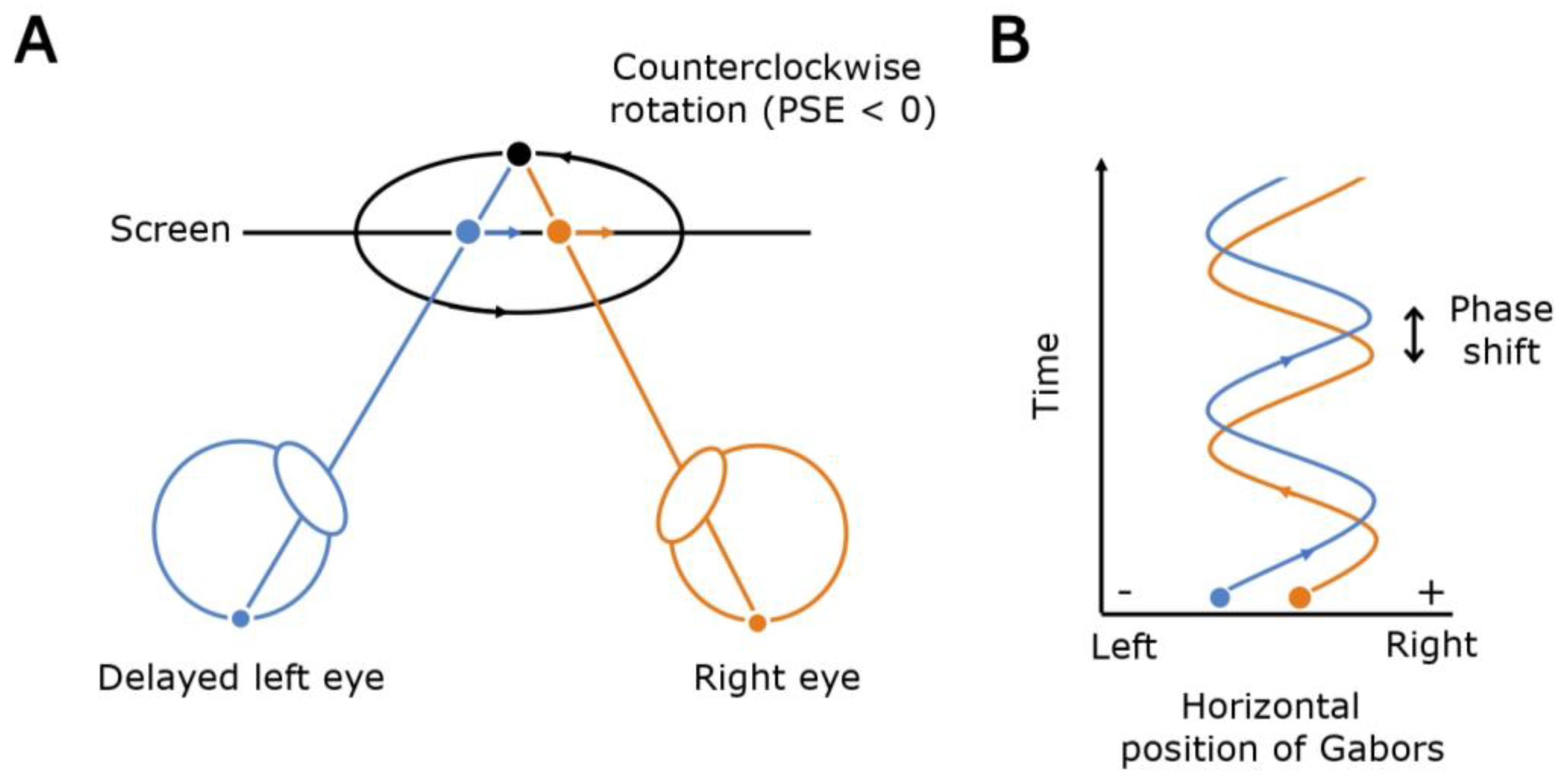
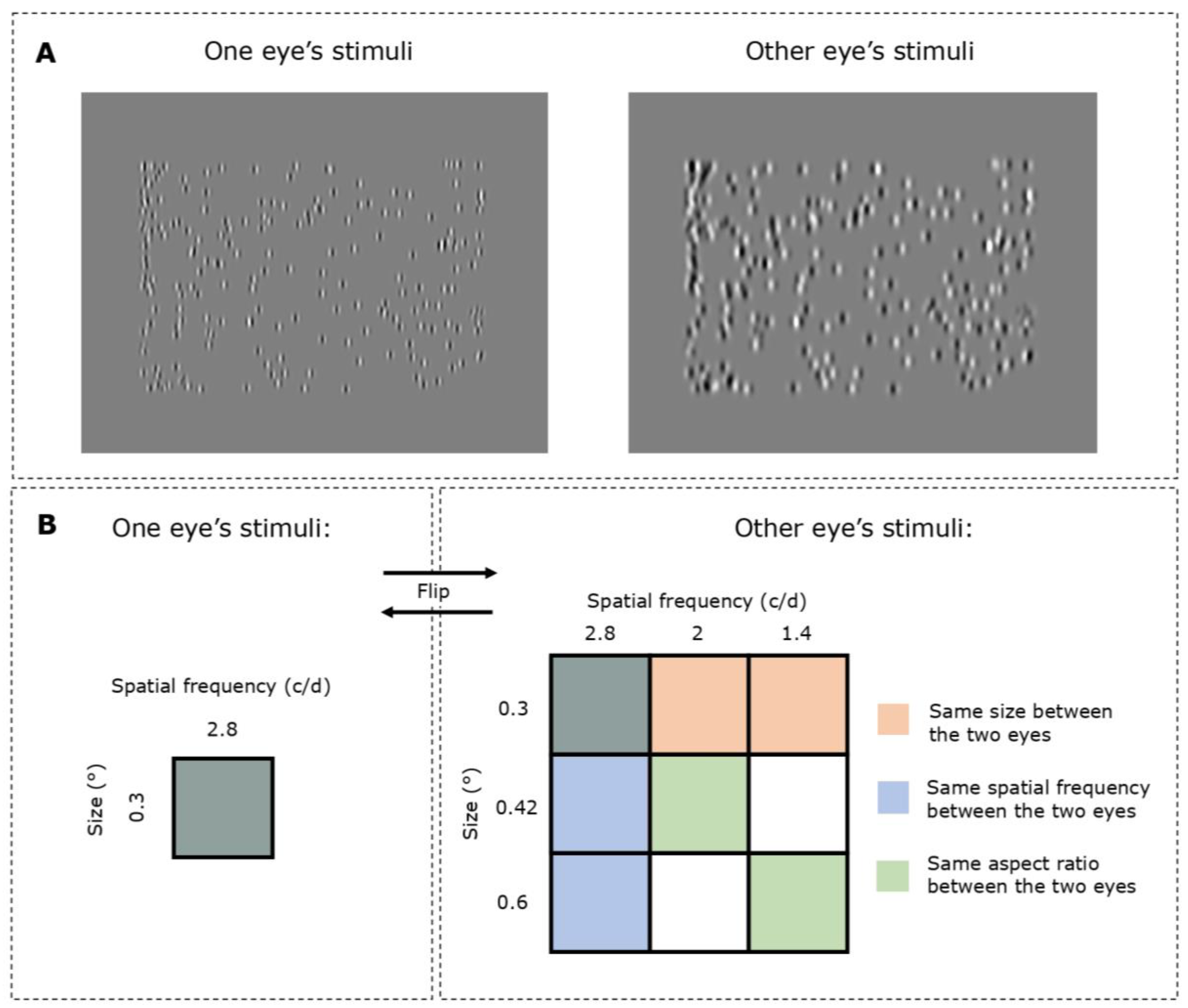
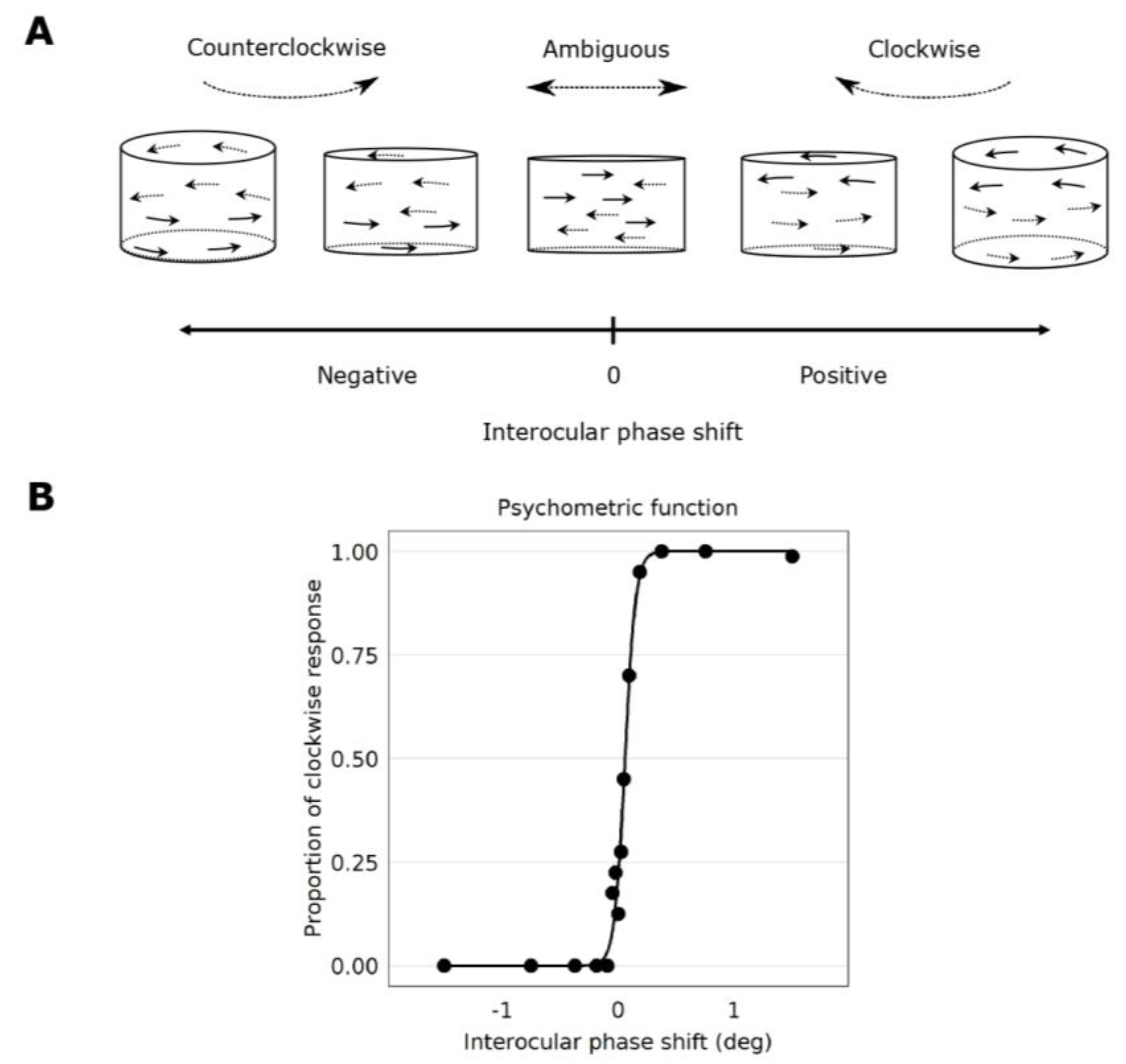
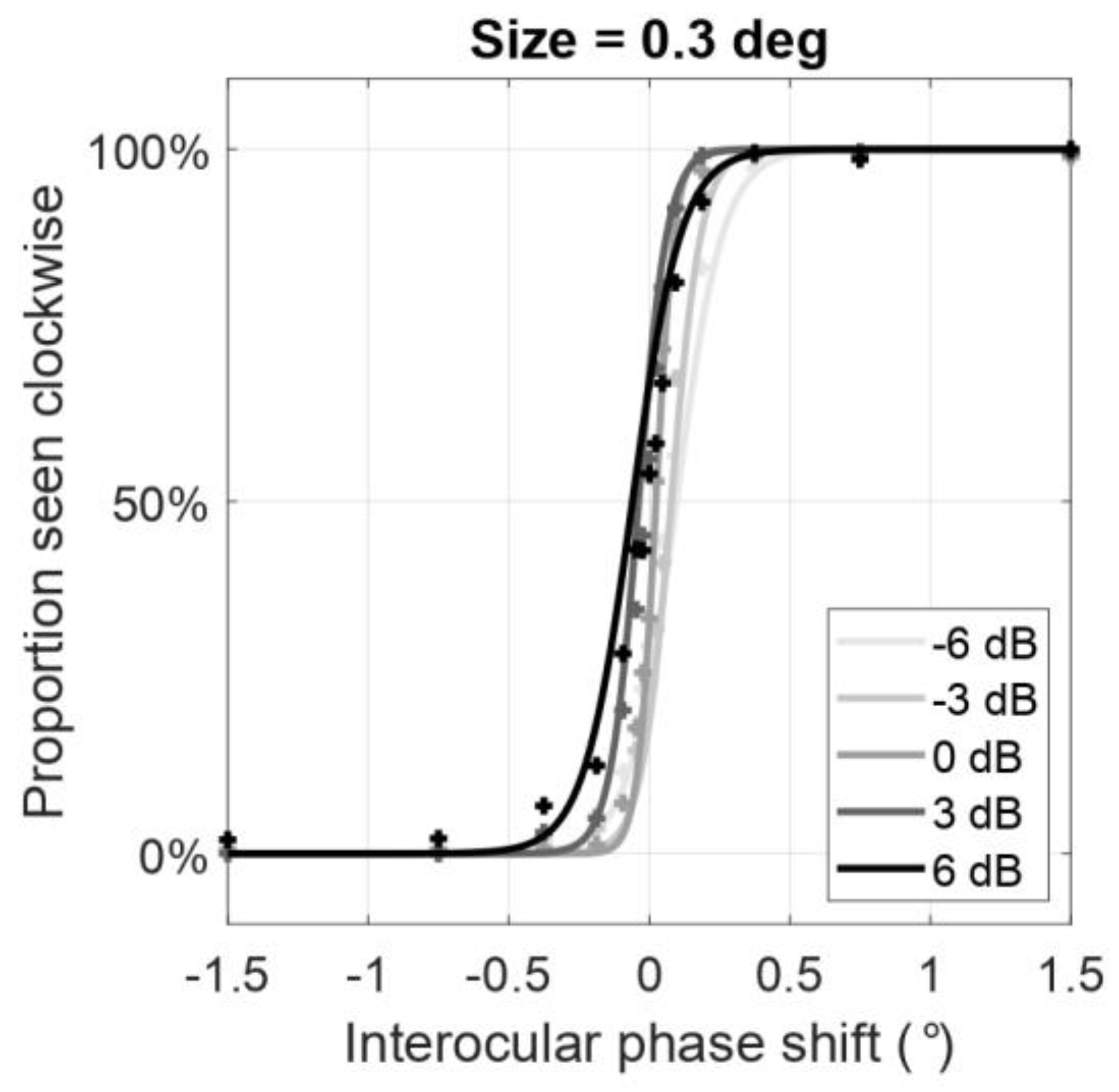

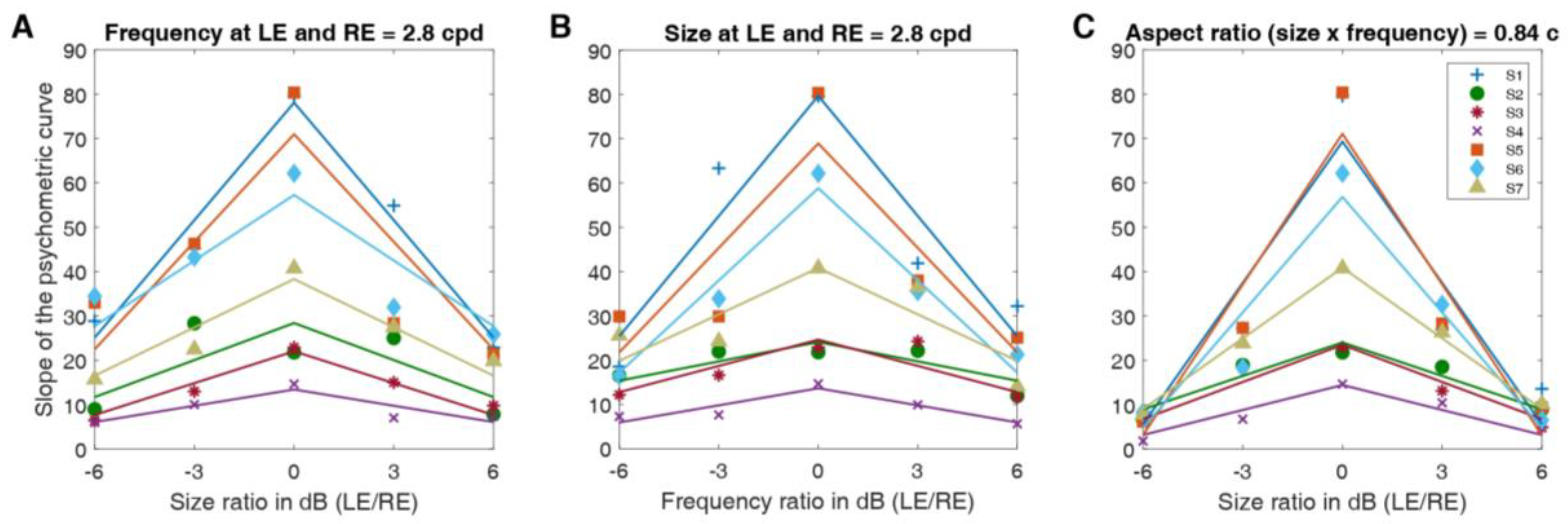

© 2020 by the authors. Licensee MDPI, Basel, Switzerland. This article is an open access article distributed under the terms and conditions of the Creative Commons Attribution (CC BY) license (http://creativecommons.org/licenses/by/4.0/).
Share and Cite
Min, S.H.; Reynaud, A.; Hess, R.F. Interocular Differences in Spatial Frequency Influence the Pulfrich Effect. Vision 2020, 4, 20. https://doi.org/10.3390/vision4010020
Min SH, Reynaud A, Hess RF. Interocular Differences in Spatial Frequency Influence the Pulfrich Effect. Vision. 2020; 4(1):20. https://doi.org/10.3390/vision4010020
Chicago/Turabian StyleMin, Seung Hyun, Alexandre Reynaud, and Robert F. Hess. 2020. "Interocular Differences in Spatial Frequency Influence the Pulfrich Effect" Vision 4, no. 1: 20. https://doi.org/10.3390/vision4010020
APA StyleMin, S. H., Reynaud, A., & Hess, R. F. (2020). Interocular Differences in Spatial Frequency Influence the Pulfrich Effect. Vision, 4(1), 20. https://doi.org/10.3390/vision4010020




